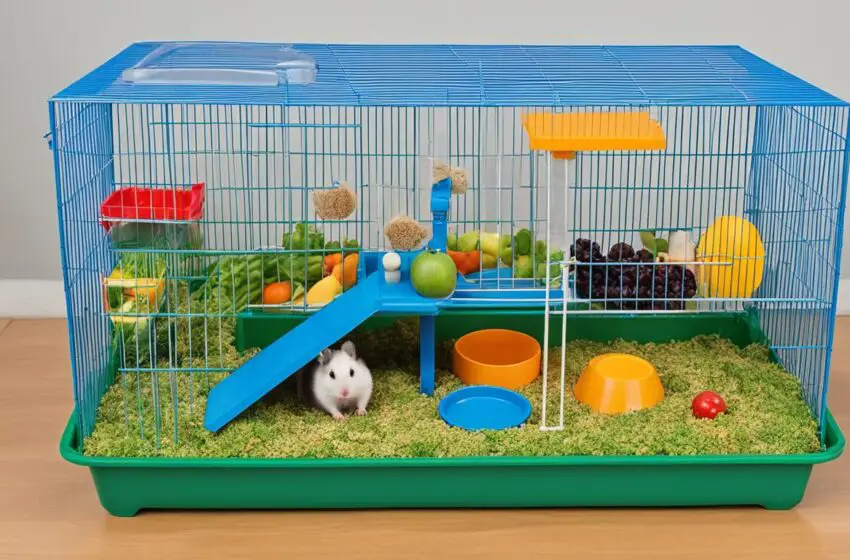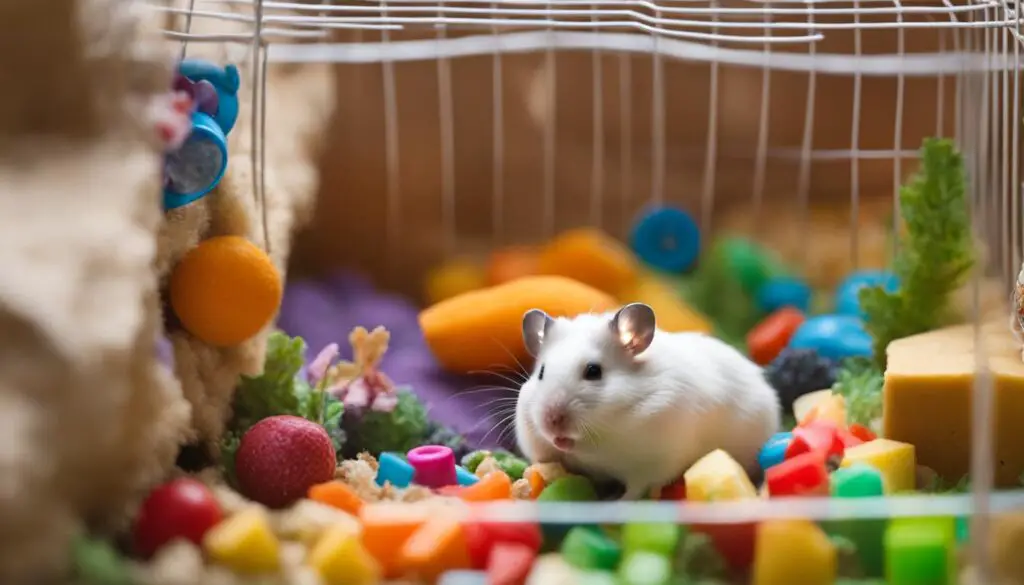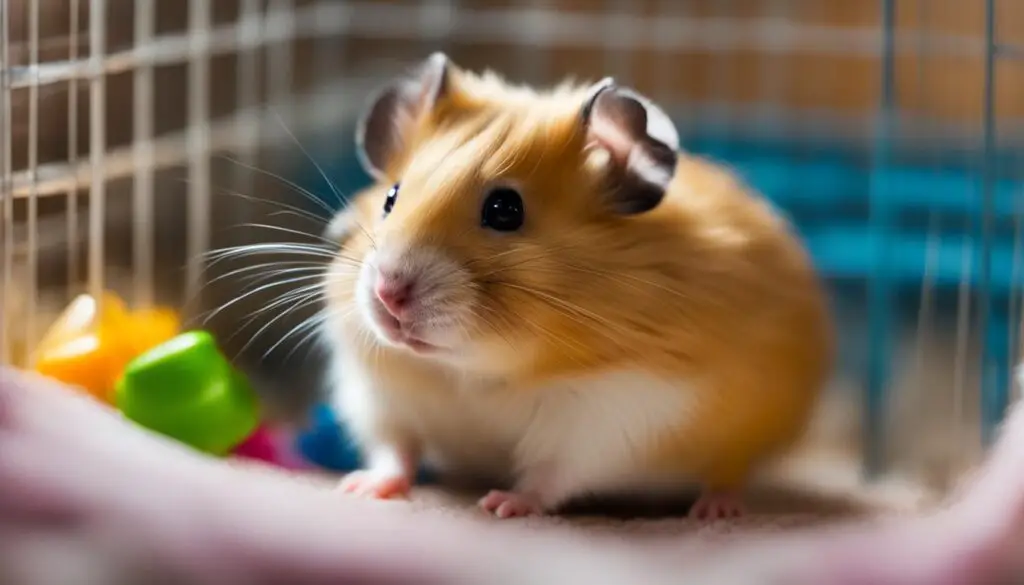The Complete Guide to Essential Hamster Care Guidelines

As a hamster owner, it is important to understand the essential care guidelines that will ensure the health and well-being of your furry friend. Providing proper care, nutrition, and a suitable habitat are crucial for their happiness and longevity. In this comprehensive guide, I will share expert tips and advice on hamster care, helping you create the perfect environment for your hamster to thrive.
Key Takeaways:
- Providing a balanced and nutritious diet is vital for your hamster’s health.
- Creating a suitable habitat with proper ventilation and comfortable bedding ensures their well-being.
- Regular exercise, mental stimulation, and playtime are essential for hamsters.
- Maintaining your hamster’s health includes regular vet visits, hygiene, and grooming.
- Proper handling and socialization build a strong bond with your hamster.
Understanding the Nutritional Needs of Hamsters
Providing a balanced and nutritious diet is crucial for the health of your hamster. Hamsters have specific nutritional needs that must be met to ensure their overall well-being and longevity. A carefully planned diet is essential to support their growth, maintain their energy levels, and prevent any potential health issues.
When it comes to hamster nutrition, a key factor to consider is variety. Hamsters thrive on a diverse diet that includes a combination of fresh fruits and vegetables, high-quality hamster pellets, and occasional treats. This variety ensures that they receive a wide range of essential nutrients.
Dietary Guidelines for Hamsters
In order to provide a balanced hamster diet, consider the following guidelines:
- High-quality hamster pellets: These should make up the majority of your hamster’s diet. Look for pellets that are specifically formulated for hamsters and free from artificial colors and preservatives. These pellets provide the necessary vitamins, minerals, and proteins that are crucial for their health.
- Fresh fruits and vegetables: Offer a variety of fresh produce to your hamster, including leafy greens like spinach and kale, as well as small amounts of fruits like apples, berries, and carrots. These provide essential vitamins and fiber.
- Occasional treats: While treats should be given sparingly, they can be used as a reward or for enrichment. Opt for hamster-safe options like plain, unsalted nuts or small pieces of dried fruits.
- Avoid toxic foods: Some foods can be harmful or toxic to hamsters. Chocolate, caffeine, onions, garlic, and citrus fruits should be strictly avoided, as they can be poisonous and cause health issues.
In addition to a balanced diet, it’s important to provide your hamster with a constant supply of fresh, clean water. Change their water daily to ensure that it remains free from contaminants and is readily available for hydration.
“A balanced and varied diet is essential for hamsters to thrive. It’s crucial to provide them with high-quality pellets, fresh fruits and vegetables, and occasional treats while avoiding toxic foods.”
By following these guidelines and providing a balanced hamster diet, you can ensure that your furry friend receives the necessary nutrients for optimal health and well-being.
Creating a Suitable Habitat for Your Hamster
Creating the perfect habitat for your hamster is crucial for their overall well-being and happiness. A suitable hamster habitat should provide them with a safe and comfortable living space, allowing for natural behaviors and activities.
Choosing the Right Hamster Cage
The first step in creating a suitable habitat for your hamster is selecting the right cage. It’s important to choose a cage that is spacious enough to allow your hamster to move around freely. A cage with multiple levels or compartments can provide additional space for exercise and exploration.
Tip: Look for cages with narrow bar spacing to prevent your hamster from escaping.
Ensure that the cage has proper ventilation to maintain a fresh and healthy environment. Hamsters are sensitive to temperature and humidity, so it’s essential to provide adequate airflow.
Bedding for Comfort and Hygiene
The bedding you choose for your hamster’s cage is critical for their comfort and hygiene. Opt for bedding materials such as aspen or paper-based bedding, which are safe and absorbent. These types of bedding help control odors and provide a cozy environment for your hamster to burrow and nest.
Tip: Avoid using cedar or pine bedding, as they can be harmful to your hamster’s respiratory system.
Enrichment and Exercise
Hamsters are active animals and need plenty of mental and physical stimulation. Including toys, tunnels, and hideouts in their habitat is essential for providing enrichment. These items allow your hamster to explore, climb, and play, promoting their overall well-being.
Place toys and hideouts strategically throughout the cage to create an engaging environment that encourages your hamster to stay active. Consider providing chew toys to promote dental health and prevent boredom.
Maintaining Hygiene
Regular cleaning of your hamster’s cage is crucial to maintain optimal hygiene. Remove any soiled bedding or waste on a daily basis, and thoroughly clean the cage once a week. Use a pet-safe disinfectant to ensure cleanliness without harming your hamster.
Tip: While cleaning the cage, provide a separate temporary enclosure for your hamster to ensure their safety.
A clean and well-maintained habitat not only promotes the health and hygiene of your hamster but also helps prevent the growth of bacteria or parasites that could harm your pet.

Exercise and Enrichment for Hamsters
Hamsters are active creatures that require regular exercise and mental stimulation. To ensure their overall well-being, it is essential to provide them with opportunities for physical activity and enrichment.
Exercise Wheels and Hamster Balls
Exercise wheels: An exercise wheel is a must-have for your hamster’s cage. It allows them to engage in natural running behavior and helps them burn off excess energy. Choose a wheel that is appropriately sized for your hamster to prevent any injuries or discomfort. Plastic wheels with solid running surfaces are highly recommended to avoid the risk of your hamster’s feet getting stuck.
Hamster balls: Hamster balls are another great way to provide exercise and mental stimulation. These transparent balls allow your hamster to explore outside their cage while keeping them safe. Supervise your hamster’s time in the ball and provide them with enough space to move around and explore freely.
Toy Variety and Chew Items
Offering a variety of toys and chew items in your hamster’s cage is essential for their mental stimulation and dental health.
“For mental stimulation, make sure to provide chew toys and puzzle toys like treat balls, hiding treats inside paper tubes.” – Dr. Jane Smith, DVM
Chew toys: Hamsters have constantly growing teeth, and providing them with appropriate chew toys is crucial. Chew toys help wear down their teeth and prevent overgrowth, which can be painful. Wooden toys, cardboard tubes, and mineral chews are excellent options for satisfying their natural chewing instincts.
Puzzle toys: Introduce puzzle toys to engage your hamster’s problem-solving abilities. These toys can provide mental stimulation and prevent boredom. Consider treat balls or toys that allow your hamster to forage for food, stimulating their natural instincts to search and explore.
Playtime Outside the Cage
While exercise within the cage is important, providing supervised playtime outside the cage is equally essential for your hamster’s well-being.
“Supervised playtime outside the cage provides additional mental stimulation and helps prevent cage-related stress.” – Dr. Sarah Johnson, DVM
Ensure the play area is safe and free from any hazards. Use a playpen or secure the area with appropriate barriers to prevent your hamster from escaping or getting injured. Let your hamster explore, crawl, and climb on safe objects while keeping a close eye on their activities.
Recommended Hamster Exercise and Enrichment Products
| Product Name | Product Description | Price |
|---|---|---|
| Wodent Wheel | A silent and safe exercise wheel made from durable plastic. | $25.99 |
| Run-about Ball | A transparent ball that allows your hamster to roam and explore outside the cage. | $9.99 |
| Kaytee Lava Ledge Chew Toy | A volcanic rock chew toy for satisfying your hamster’s natural chewing instincts. | $4.99 |
| Busy Buddy Tug-A-Jug | A treat-dispensing puzzle toy for mental stimulation. | $12.99 |
By providing your hamster with the necessary exercise tools, a variety of toys, and regular opportunities for playtime outside the cage, you can ensure they stay physically and mentally stimulated, promoting their overall well-being and happiness.
Maintaining Hamster Health and Hygiene
Ensuring the health and hygiene of your hamster is of utmost importance for their overall well-being. Regular veterinary visits, proper cage cleaning, dust baths, and grooming routines are vital for maintaining your furry friend’s health. Let’s explore some essential practices to keep your hamster in optimal condition.
Veterinary Care
Regular visits to a veterinarian who specializes in small animals, such as hamsters, can play a significant role in preventing and detecting health issues. Veterinarians can provide vaccinations, conduct thorough check-ups, and offer valuable advice on preventive care. These proactive measures help ensure that your hamster stays healthy and receives immediate attention if any health concerns arise.
Cage Cleaning and Maintenance
Keeping your hamster’s cage clean is crucial for maintaining good hygiene and preventing the spread of disease. Regularly remove any waste, uneaten food, and soiled bedding. Use a mild, hamster-safe disinfectant to clean the cage thoroughly. Be sure to rinse and dry the cage before replacing the bedding and allowing your hamster to return to its clean living environment.
Dust Baths for Certain Hamster Breeds
Some hamster breeds, such as Syrian hamsters and Roborovski hamsters, enjoy taking dust baths. These baths help keep their fur clean, remove excess oils, and prevent fur matting. Prepare a shallow container with hamster-safe bathing dust, available at pet stores, and allow your hamster to roll and play in it for a short period. Remember to remove the dust bath after use to avoid excessive dust exposure.
Grooming Your Hamster
Grooming your hamster’s fur is important to maintain its cleanliness and overall condition. While hamsters are generally self-groomers, you can assist by gently brushing their fur with a soft-bristled toothbrush or a small pet grooming brush. This helps remove any loose fur, prevents tangles or matting, and promotes a healthy coat. It’s essential to approach grooming with patience and gentleness to avoid causing your hamster any stress or discomfort.
| Hamster Health and Hygiene Tips |
|---|
| Visit a veterinarian regularly for check-ups and preventive care. |
| Clean the hamster’s cage regularly to maintain proper hygiene. |
| Provide a dust bath for certain hamster breeds. |
| Gently groom your hamster’s fur to keep it clean and healthy. |
By prioritizing your hamster’s health and hygiene, you can ensure that they lead a happy and active life. Remember to observe your hamster closely, looking out for any signs of illness or injury, and consult a veterinarian if you have any concerns. With proper care and attention, your hamster will thrive and bring you joy for years to come.

Handling and Socializing Your Hamster
Proper handling and socialization are crucial for building a strong bond with your hamster and earning their trust. By following a few essential guidelines, you can ensure a positive and enriching experience for both you and your furry friend.
Approaching Your Hamster
When approaching your hamster, it’s important to remain calm and gentle. Hamsters have sensitive senses, so allow them to become familiar with your scent and presence before attempting any physical contact. Place your hand near the cage and allow them to sniff and investigate you at their own pace.
Gradual Introduction to Handling
Start by gently petting your hamster while they are in their cage. This helps to familiarize them with your touch and build a sense of security. Gradually progress to picking them up, starting with short periods of holding and gradually increasing the duration as your hamster becomes more comfortable. Never force your hamster to be held if they show signs of stress or resistance. Respect their boundaries and give them time to adjust.
Bonding through Quality Time
Spend quality time with your hamster to strengthen your bond. Allow them to explore and play in a safe and secure area outside of their cage under your supervision. Use gentle petting, talking softly to your hamster, and offering treats as positive reinforcement. This will help them associate your presence with positive experiences and build trust over time.
Remember, every hamster is unique, and it may take time for them to feel comfortable and trusting. Patience and consistency are key when socializing your hamster.
Conclusion
In conclusion, caring for a hamster involves meeting their nutritional needs, creating a suitable habitat, providing exercise and enrichment, maintaining their health and hygiene, and fostering socialization. By following these essential hamster care guidelines, you can ensure the well-being and happiness of your furry friend. Each hamster is unique, so it’s important to observe their behavior and make adjustments accordingly.
By providing a balanced and nutritious diet, a spacious and secure habitat, opportunities for exercise and mental stimulation, regular veterinary care, and gentle handling, you can create a loving and nurturing environment for your hamster to thrive. Remember to constantly monitor your hamster’s health and provide them with the necessary care to prevent illness and ensure their longevity.
Hamsters are wonderful pets that bring joy and companionship to our lives. By being attentive and responsible caregivers, we can forge a strong bond with our hamsters and provide them with the best possible care. With these essential hamster care guidelines in mind, you can create a happy and healthy life for your furry companion.
FAQ
What should I feed my hamster?
Hamsters require a balanced diet consisting of fresh fruits and vegetables, high-quality hamster pellets, and occasional treats. Avoid feeding them toxic foods like chocolate or caffeine.
How do I create a suitable habitat for my hamster?
Provide your hamster with a spacious and secure cage with proper ventilation. Line the cage with suitable bedding materials like aspen or paper-based bedding. Also, ensure they have enough space to exercise, toys for mental stimulation, and regular cleaning of the cage.
How can I exercise and enrich my hamster’s life?
Provide your hamster with an exercise wheel or hamster ball for running and exploring. Offer them a variety of toys and chew items to keep their teeth healthy and prevent boredom. Regular playtime outside the cage, under supervision, is also recommended.
How often should I take my hamster to the veterinarian?
Regular visits to a veterinarian are essential for maintaining your hamster’s health. They can provide vaccinations, perform check-ups, and offer preventive care advice. Additionally, maintaining proper hygiene by cleaning the cage, providing dust baths, and grooming is important.
How do I build a bond with my hamster?
Approach your hamster calmly and gently, allowing them to become familiar with your scent and presence. Gradually introduce handling, starting with short periods of interaction and gradually increasing the duration. Spending quality time with your hamster through gentle petting and playtime can help strengthen your bond.
What are the essential hamster care guidelines?
The essential hamster care guidelines include providing proper nutrition, creating a suitable habitat, ensuring regular exercise and mental stimulation, maintaining hygiene and health, and building a bond with your hamster through handling and socialization.



